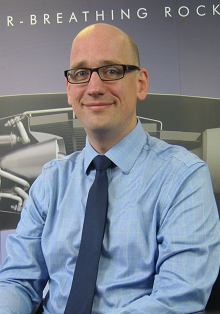Ahead of Aviation Aerodynamics 2016, the Institution spoke to James Barth, Lead Aerodynamicist at Reaction Engines. James explains his role and involvement in aerodynamics, how important aerodynamics is in designing more efficient aircraft, where he sees the next big developments and what he is most looking forward to by attending.
 James Barth, Lead Aerodynamicist, Reaction Engines
James Barth, Lead Aerodynamicist, Reaction Engines
Prior to joining Reaction Engines, James has worked on fluid dynamics problems ranging from micro-scale multiphase flows through large-scale industrial processes. He studied operational mode transition inside a rocket-based combined cycle engine at JAXA during an MSc in Space Sciences from International Space University.
He then completed a PhD in Aerospace Engineering at the University of Queensland, focused on fuel injection and combustion efficiency improvements in a Mach 12 scramjet.
As part of REL’s Performance and Aerodynamics team, and in collaboration with industrial partners, he works on modelling and testing the aerodynamics of the SABRE engine and its subsystems.
Q: Could you briefly explain your role and involvement in aerodynamics?
James Barth: As lead aerodynamicist at Reaction Engines Ltd, I work alongside our team of Performance and Aerodynamics engineers to develop and support development of every SABRE component that has an aerodynamic aspect. Together with the rest of the Reaction Engines team, we work on everything from air intakes to combustors to rocket nozzles. CFD is one of our main tools for aerodynamic work, but we also collaborate across the entire company to develop and conduct experimental investigations.
On any given day I might be running simulations, interrogating experimental data, or using these in combination to improve the aerodynamic aspects of an engine subsystem. I personally have technical responsibility for the air intake and bypass (ramjet) burner subsystems, and work closely with our industry partner Bayern-Chemie, a subsidiary of MBDA, to make sure these systems will be ready on time and on spec.
Q: What are you most looking forward to by attending and presenting at Aviation Aerodynamics?
JB: As an attendee, I’m looking forward to a chance to listen and learn from a range of speakers on a number of fascinating areas at the forefront of innovation in the industry. I’m particularly keen to learn about new developments in aerodynamic testing and simulation; working on challenging aerodynamic problems in the context of a novel air-breathing propulsion system means I’m always on the look-out for new tools that could help us form the best possible solution.
As a presenter, I’m excited for the chance to talk about aerodynamic challenges in SABRE-class engines to an aviation audience. We often spend a lot of time talking about these engines in the context of spaceplanes, but there’s numerous ways SABRE and its underlying technologies can be used without ever leaving the atmosphere!
Q: How important is the aspect of aerodynamics in designing more efficient aircraft?
JB: Aerodynamics’ place in the design loop has grown more central as engineers are able to confidently adopt new shapes and configurations that improve vehicle aerodynamics and engine performance. From low-NOx combustors, to modern wing profiles, to novel vehicles and entire engines, aerodynamics has had a huge role in guiding and optimising the design of modern aviation systems.
In many ways, we aerodynamicists owe a great debt to the minds behind the materials and manufacturing improvements that have allowed us to move away from the ‘brute force’ aero design of yesteryear, to solutions involving novel geometric shapes (and often lower masses) that come from aerodynamic optimisation. At REL we often look to improving aerodynamic performance as a means to shave mass off of SABRE – in the context of space access, every kilogram counts.
Q: What do you think the next biggest developments in aviation aerodynamics will be?
JB: I’m excited about the prospect of there being a renaissance in supersonic flight. Start-ups and established companies alike are actively developing a range of supersonic business and commercial passenger jets. Agencies and primes are actively collaborating to mitigate aerodynamic problems like sonic boom, which would otherwise limit our ability to use supersonic vehicles on over-land commercial routes. In parallel, researchers around the world are finally cracking a number of the challenges in efficient high-speed propulsion.
We at REL have developed the technology not only to push the operational speed of conventional aviation engines well beyond Mach 2, but also to develop engines that could make hypersonic aviation a possibility. The world of tomorrow could be a much smaller place than it is today!
James Barth will be speaking at Aviation Aerodynamics 2016, the only engineering-focused event on the latest developments in both internal and external aerodynamics to reduce fuel usage and increase flight efficiency.
Programme highlights:
- Airbus share on the significant BLADE project and enabling natural laminar flow through design
- European Space Agency present on aerodynamics for re-entry space vehicles, in particular the Exo-Mars project
- The new innovation the Sabre (Synergetic Air-Breathing Rocket Engine) from Reaction Engines
- QinetiQ share their latest advances in simulating a plane in a wind tunnel through the use of an electric motor
- An exclusive update from Clean Sky Joint Undertaking on plans for Clean Sky 2
- Rolls-Royce’s UltraFan™, a new design concept to ensure greater efficiency in the engine
For further information, please visit the
Aviation Aerodynamics 2016 event page.